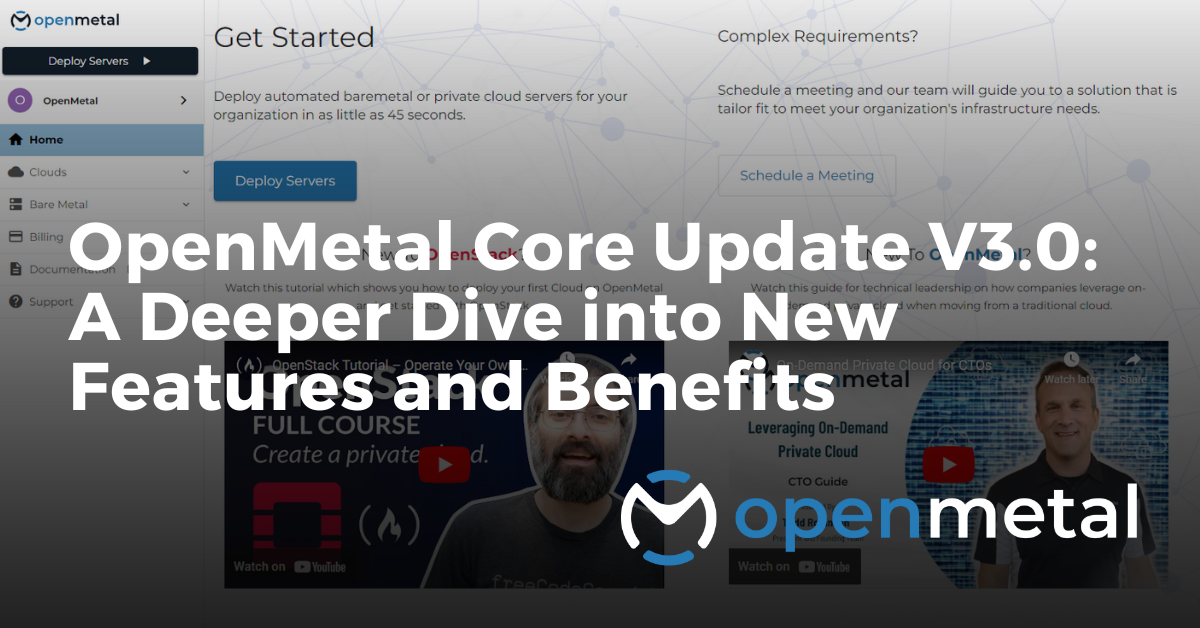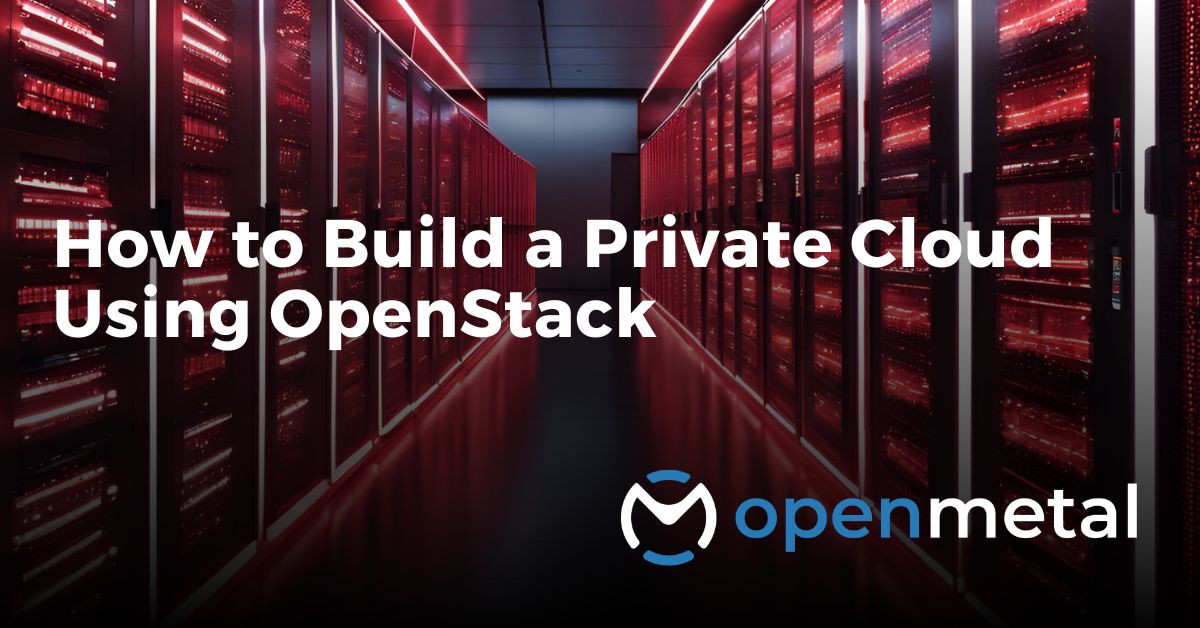OpenMetal’s V3.0 Core update is packed with technical upgrades and exciting new improvements. This version delivers enhanced performance, simplified infrastructure management, improved resource control, and more.
Let’s get into how these updates translate to real-world benefits for our users:
Enhanced Performance and Networking
Don’t fall behind on the latest software advancements or miss out on performance gains!
V3.0 upgrades the base operating system to CentOS 9 Stream and utilizes Linux Kernel v5.14+. This allows access to advanced virtualization features like Intel AMX, upping performance for demanding workloads.
Businesses running high-performance computing (HPC), AI/ML, or data-intensive applications using our hardware should see significant performance improvements.
V3.0 also moves to NetworkManager for more efficient and fully managed network configuration.
Neutron additionally provides optional OVN support for optimized network virtualization. The addition of Neutron metering, trunking, packet logging, port forwarding, and QoS plugins provides precise control over network traffic, security, and monitoring. Distributed floating IP support improves network performance by allowing traffic to enter from the node where a VM is located instead of traversing the tunnels between nodes.
Businesses with complex networking needs or those looking to optimize network performance for applications like e-commerce or online gaming will benefit from this improved flexibility and efficiency.
- CentOS 9 Stream: Moving to CentOS 9 Stream provides a more up-to-date and secure base operating system. This means better compatibility with modern software, access to the latest security patches, and a more stable platform overall.
- Linux Kernel v5.14+: This kernel upgrade unlocks advanced virtualization features like Intel AMX, boosting performance for demanding workloads such as machine learning and AI.
- In-place upgrades: Minimizes disruption by allowing existing CentOS 8 Stream deployments to be upgraded seamlessly. This saves valuable time and resources during the transition.
- NetworkManager: Simplifies network configuration and management, eliminating the complexities of manual configuration via network-scripts.
- Neutron Advancements: Optional OVN driver support, distributed floating IPs, and various plugin enablements (metering, trunking, packet logging, port forwarding, QoS) offer granular control over networking, enhanced security, and improved monitoring capabilities.
Simplified OpenStack Upgrades and Reduced Downtime
Frequent OpenStack upgrades can be complex and time-consuming, slowing down operations for IT teams.
The adoption of the “Bobcat” OpenStack release introduces SLURP (Skip Level Upgrade). This means fewer mandatory upgrades by allowing you to skip intermediate versions. This also means you can upgrade directly from one SLURP release to the next, keeping your clusters up-to-date without the hassle of frequent, incremental upgrades.
For organizations with limited IT resources or prioritizing business continuity, SLURP upgrades streamline OpenStack management, minimizing downtime and maintenance overhead.
- OpenStack 2023.2 “Bobcat”: This SLURP (Skip Level Upgrade) release offers long-term support and ensures easy upgrades to future SLURP releases. This reduces the frequency and complexity of upgrades, freeing up IT teams to focus on more interesting items!
- Kolla-Ansible v17.3: Keeps the underlying deployment and management tools up-to-date, ensuring stability and access to the latest features and bug fixes.
Optimized Resource Control and Better Security
Many organizations struggle with inefficient resource allocation and limited control, leading to a less secure and harder to manage infrastructure.
Nova now dynamically calculates memory reservation based on node type and disk count. Overcommit ratios and reservations can be fine-tuned for CPU and memory, enabling precise resource control. The optional SPICE console further improves flexibility and remote management capabilities as an alternative to VNC/noVNC.
Businesses can take advantage of these options to optimize resource utilization and costs by tailoring resource allocation to specific workload requirements.
Additionally, the Keystone updates in OpenMetal V3.0 enhance security and simplify administration. By removing the deprecated Keystone admin interface and transitioning to the standard internal interface, we’ve been able to strengthen security by eliminating a potential vulnerability. Further, the shift from the deprecated _member_ role to the standard member role improves clarity and simplifies user management for administrators.
These changes contribute to a more secure and streamlined experience for managing user access and permissions within the OpenMetal platform.
- Keystone Simplification: Removing the Keystone admin interface and deprecated roles reduces complexity and enhances security by minimizing potential attack surfaces.
- Nova Enhancements: Dynamic resource allocation, SPICE console support, and improved power management capabilities in Nova translate to greater efficiency, better resource utilization, and a more user-friendly experience.
Robust and Easier-to-Use Storage
Ceph can be tough to manage and present challenges with scaling and maintenance.
The upgrade to Ceph v18.2.2 “Reef” and the shift to cephadm simplifies cluster management. This means easier configuration changes, disk/OSD management, and service scaling.
It also brings performance improvements to RocksDB, the underlying database used by Ceph, leading to faster read and write operations.
The introduction of the “read balancer” feature allows for more even distribution of primary PGs (Placement Groups) across the cluster, preventing performance bottlenecks and ensuring consistent performance. This intelligent balancing, combined with the performance boost from RocksDB, ensures that your storage is reliable and powerful.
Organizations using Ceph for scalable storage will appreciate the reduced management burden and improved operational efficiency.
- Ceph v18.2.2 “Reef”: This upgrade brings significant performance improvements, especially for RocksDB, along with enhanced multi-site replication and extensive dashboard updates.
Cephadm: Simplifies Ceph cluster management by replacing ceph-ansible with a more user-friendly and feature-rich tool.
Expanded Toolset for Automation and Orchestration
A lack of integrated tools for automating tasks and managing workflows can lead to less efficient business operations.
The inclusion of the Mistral workflow service empowers users to automate repetitive tasks like backups, upgrades, and maintenance. This reduces manual effort and the potential for human error. DevOps teams and IT administrators can use Mistral to automate infrastructure management, saving time and freeing teams up for other tasks.
The Magnum update in OpenMetal V3.0 expands Kubernetes support up to v1.26.x, ensuring users can access the latest features and security updates of this popular container orchestration platform. This update also reflects the changing container landscape by deprecating the Docker Swarm driver and removing the Mesos driver, streamlining the platform and focusing on the most widely adopted technologies. This allows us to dedicate more resources to supporting and optimizing the most popular and robust containerization solutions for our users.
- Magnum Updates: Expanded Kubernetes support up to v1.26.x ensures compatibility with the latest container orchestration technologies, while deprecating older drivers streamlines the platform.
- Mistral Workflow Service: Enables automated workflows and scheduled tasks, simplifying complex operations like backups, upgrades, and maintenance.
Wrapping Up
OpenMetal V3.0 is a significant upgrade that delivers a more powerful, efficient, and user-friendly cloud platform. By addressing common user pain points and incorporating the latest and greatest technologies, we hope to empower organizations to more easily optimize their cloud infrastructure, streamline operations, and drive innovation.
Read the full engineering release notes here for OpenMetal Core Update V3.0
Want to check out these upgrades to our hosted on-demand private cloud powered by OpenStack?
Questions? Contact us.
Read More on the OpenMetal Blog
How to Build a Private Cloud Using OpenStack
So, you want your own private cloud! Now you have to figure out your options for getting there. As a huge fan of open source, we recommend you build a private cloud on OpenStack.
OpenStack is often seen as a way to create a private cloud but it is equally important as an overall Infrastructure as a Service or Data Center management software. This article focuses on the private cloud aspect of OpenStack since most research starts on how to set up private cloud with OpenStack.
Fast, Cost Effective Ways To Get Started On Private Clouds
The traditional approach of building and managing on-premises infrastructure is often not a viable option for businesses seeking the best infrastructure solution. So what’s the fastest, cost effective way to get access to cloud resources? Hosted private clouds by OpenMetal. Say goodbye to lengthy setup times, risks, and costly infrastructure investments. With our Hosted Private Cloud, you can deploy your own private cloud in just 45 seconds.
What Are The Advantages Of Using OpenStack To Create A Cloud Environment
Explore the advantages of using OpenStack to create a cloud environment and attempt to quantify those benefits for your organization. For small and medium sized organizations, high cloud spend is not something they can afford. And as time has passed and OpenStack has evolved, the barriers to getting started on OpenStack are lower and the savings make it hard to ignore.






































